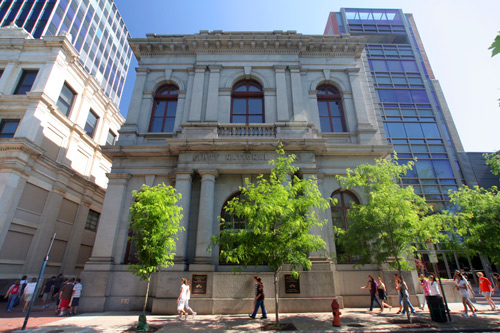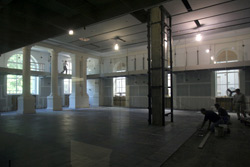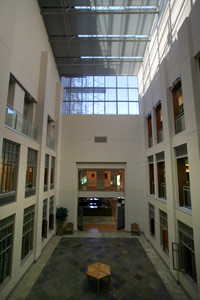25 June 08: Chemical substance
 Philadelphia's next major museum opening will not be the Barnes, nor the Calder, nor even the new Please Touch Museum at Memorial Hall in Fairmount Park. No, our next museum is set to open this fall as an understated, underrated, and perhaps even unexpected permanent display of that less sexy science: chemistry. The Chemical Heritage Foundation (CHF) has stood amidst the most historic mile in America for the past 13 years, quietly growing into an institution that many tour groups -- and locals -- pass by with little more than a notice of the Center City District sign indicating it's there, right next to the entrance to Franklin Court and across the street from Carpenters Hall. That should change this fall, when the Museum at CHF opens with the Making Modernity exhibit in the former First National Bank Building.  Using LEED principles, including new insulation, wall tile made of recycled glass and bathroom floors made of recycled cans, historic renovation specialist
architects
Dagit-Saylor (now Saylor Gregg) have reinvented the Civil War era bank, which CHF purchased in 1995,
as an airy
and tall two-story
gallery, the exhibit design being done by Ralph Appelbaum Associates. Construction of the 17,000 sq ft space (pictured, right) is ongoing as we speak, its
arched front
windows looking out at Independence National Historical Park and its rear windows watching over Franklin Court and Ben's ghost house.
Using LEED principles, including new insulation, wall tile made of recycled glass and bathroom floors made of recycled cans, historic renovation specialist
architects
Dagit-Saylor (now Saylor Gregg) have reinvented the Civil War era bank, which CHF purchased in 1995,
as an airy
and tall two-story
gallery, the exhibit design being done by Ralph Appelbaum Associates. Construction of the 17,000 sq ft space (pictured, right) is ongoing as we speak, its
arched front
windows looking out at Independence National Historical Park and its rear windows watching over Franklin Court and Ben's ghost house. But what is it? The Chemical Heritage Foundation is a fully operating non-profit which, according to its mission, "serves the community of the chemical and molecular sciences, and the wider public, by treasuring the past, educating the present, and inspiring the future." But basically, CHF exists as a celebration of chemistry -- chemical engineering, molecular technology, instrumental inventions -- and how it applies to everyday life, from medicine and plastic to textiles and computers. And, as it relies entirely on donations and is still growing, it has the backing to support such a celebration. The current organization is an outgrowth of 1982's Center for the History of Chemistry, a joint project between the University of Pennsylvania and the American Chemical Society. The American Institute of Chemical Engineers joined them in 1984 as a sponsor and they were incorporated as a non-profit in 1987.  After years of renting space at Penn (and collecting donations from the likes of the Haas of Rohm & Haas and the du Pont family), CHF finally moved in '95 to
their current
location in the old Bank, designed by City Hall's architect John McArthur, Jr. Continuing its growth, CHF built an annex to the east of the Bank, the handsome
six story
office building and its adjacent conference room, designed by Philly's Purdy O'Gwynn. It opened in 2002. The old and new buildings are connected by a tall
atrium with
abundant natural light and private offices that open outward to it (pictured, left).
After years of renting space at Penn (and collecting donations from the likes of the Haas of Rohm & Haas and the du Pont family), CHF finally moved in '95 to
their current
location in the old Bank, designed by City Hall's architect John McArthur, Jr. Continuing its growth, CHF built an annex to the east of the Bank, the handsome
six story
office building and its adjacent conference room, designed by Philly's Purdy O'Gwynn. It opened in 2002. The old and new buildings are connected by a tall
atrium with
abundant natural light and private offices that open outward to it (pictured, left).With Making Modernity, the Museum at CHF, appropriately, makes a modern use out of the oldest portion of its space. The idea of the permanent exhibit is to apply an artistic eye to the scientific object; for example, take a look at the kaleidoscopic illustrations that have been made from CHF's collections HERE. What's got to be the pièce de résistance, though, is the Periodic Table of Elements. Affixed to the support columns -- "media columns" -- will be a digital representation of the Periodic Table with videos showing the elements' practical uses. What they'll use for Einsteinium (that element named for the legendary scientist of a different field) remains to be seen. The Museum at the Chemical Heritage Foundation opens on October 3 -- First Friday in Old City -- and admission is free. Normal hours start after that, Monday-Friday, 10am-4pm. While the Museum is being prepared, its curators are operating a blog called Collective Voice HERE. –B Love |
